Using Endowed Progress to increase form conversions

What motivates people to buy stuff from your website?
Of course, your product might be superior to your competitor’s or your service may have deeper benefits—but what pushes them to act and complete your forms? And why do some websites just seem to have a magic touch when it comes to their conversion rate?
What if there was a way to guide people into the process to the point where they feel committed before they’ve taken any material steps forward?
As is with a lot of topics in user experience, there’s some psychology at play here. In this case, we’re talking about the Endowed Progress Effect.
And when viewed in the context of your website’s forms, it can be a quick path to easier conversions and increased revenue.
What is the Endowed Progress Effect?
The Endowed Progress Effect is the idea that people are more likely to do something if they are given artificial advancement toward a goal.
In other words, if you make it appear they’ve made progress, they’re more likely to complete the process than if they felt like they were truly starting at the beginning.
How it works
With websites, this can be accomplished using visual cues, process modifications or smart use of existing data.
For example, if the three rows of dots below represent different ways you can finish a checkout process, the Endowed Progress (pre-completed orange dots) applied in Options 2/3 make you more likely to complete one of those options over Option 1.

The key here is that you feel like you’ve done something, though in the case of Option 2 or 3 you’ve not taken any meaningful steps forward on your own—and still have the same number of remaining steps.
The applications of this effect into website optimization are clear—you’re hoping to create greater urgency and buy-in to your conversion process as seamlessly as possible. More specifically within the conversion process, your website’s forms have a large role in how many people take the next step from consideration to purchase.
How can you leverage endowed progress in your web forms?
Build UX cues and make the first step(s) just hitting a page
Whether you show a progress bar or provide the number of steps completed and remaining, give users a checkmark for just arriving on your form. This can be a result of putting items in a cart, selecting a plan or any other purchase signal that makes them one step closer to becoming a customer.Pre-complete fields with known or likely information
Consider pre-completing form fields with known information like name or email address. Even if this is part of a longer checkout process, that “progress” makes the user more likely to continue on with the form.This is particularly valuable for businesses that do a lot of return business or who sell different product or service lines where a separate checkout process may be required.
Use a low-barrier first step
If your form requires more than a few fields to complete, consider breaking one of your “easier” fields into its own step. Completion of this field will be a gateway into the rest of the form—and the completion of “step one” is a signal to the user that they’ve made progress, even though they’re still inside the same form.
Why it works
Incomplete tasks are more likely to be done than tasks not yet started.
This slight shift in perspective helps people view a process as something that’s begun but has been interrupted—creating a strong desire to complete that process. Of course, there are many factors at play in getting someone to convert, but using an approach like endowed progress might be just the thing to help you win the psychological battle for increased conversions.



